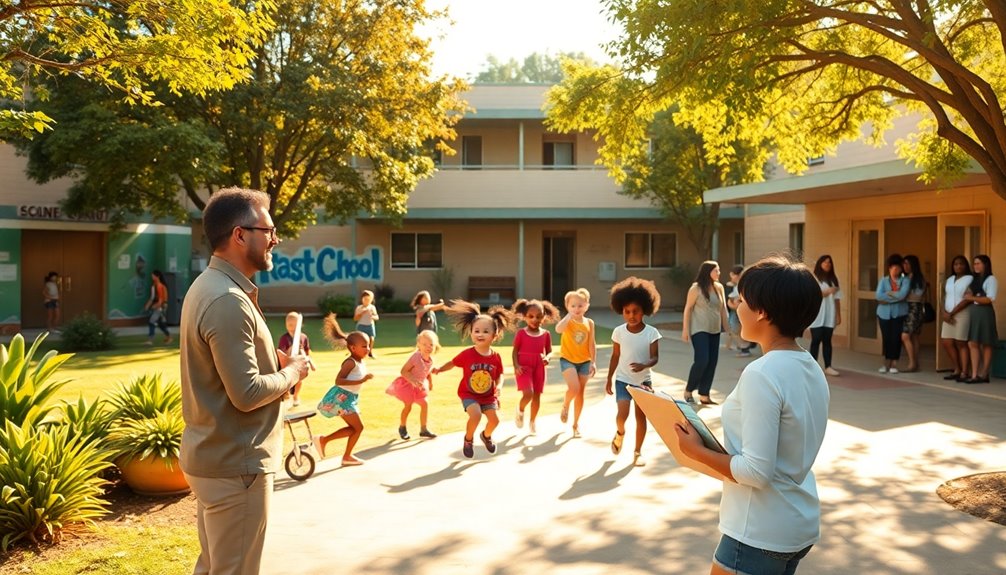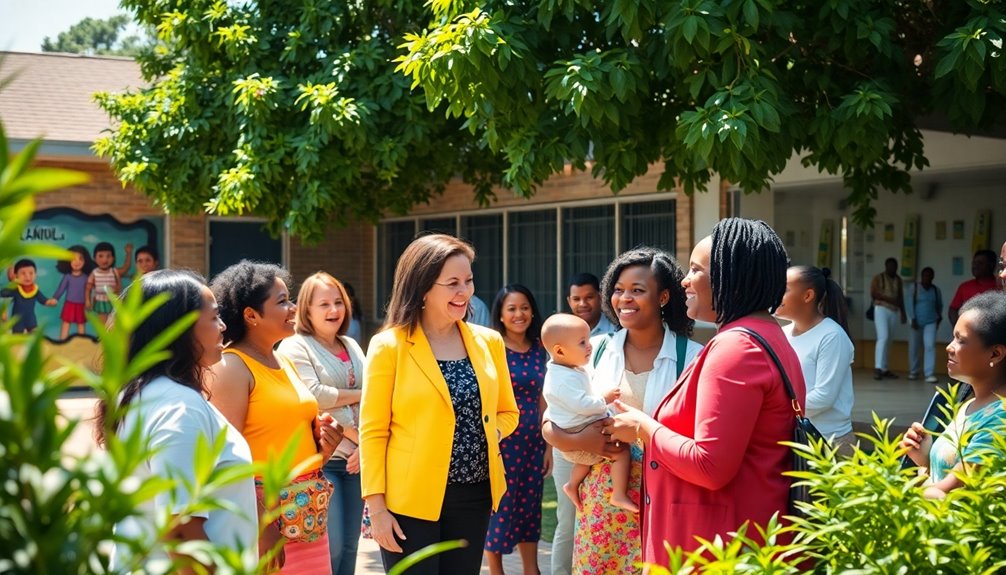As an aspiring school principal, you should ask yourself essential questions that will help shape your leadership journey. What's your leadership style, and how does it impact school culture? How will you create a safe environment for all students? How can you effectively engage parents and the wider community? Consider how you'll support teacher development and measure student success beyond just test scores. Reflect on your vision for school improvement and prepare for potential conflicts. These questions will guide your growth, and the insights here can further prepare you for your future role.
Key Takeaways
- What leadership style aligns best with my vision for creating a positive school culture and fostering collaboration among staff and students?
- How will I ensure a safe and supportive learning environment that prioritizes student well-being and promotes respect?
- In what ways can I engage parents and the community to enhance educational opportunities and foster strong partnerships?
- What strategies will I implement to support ongoing teacher development and create a culture of professional growth?
- How will I measure and evaluate student success holistically, considering various metrics beyond standardized testing?
Understanding Your Leadership Style

Understanding your leadership style is essential for aspiring school principals, as it shapes the environment you'll create for both staff and students.
By identifying whether you're more democratic, transformational, or transactional, you can tailor your approach to meet the unique needs of your school community.
Reflect on past experiences—what worked, what didn't, and how you felt in those situations. Engaging with colleagues can provide valuable feedback on your style, helping you grow.
Embrace flexibility, as different circumstances may require varying leadership approaches.
Remember, your style influences school culture, so aim for collaboration and inclusivity.
Ultimately, knowing your leadership style will empower you to foster a positive and effective learning environment.
Creating a Safe Learning Environment

Creating a safe learning environment is fundamental to student success and well-being. As a principal, you'll need to prioritize safety measures while fostering a culture of kindness and respect. Implement programs that educate students on conflict resolution and the importance of inclusivity. Regular emergency drills are essential, ensuring everyone knows what to do in critical situations.
| Safety Measure | Action Steps | Expected Outcome |
|---|---|---|
| Anti-Bullying Program | Workshops and discussions | Reduced incidents of bullying |
| Emergency Drills | Monthly practice sessions | Increased preparedness |
| Mental Health Support | Counseling and resources | Improved student well-being |
Engaging With Parents and Community

How can you effectively engage parents and the community in supporting student success? Start by establishing open lines of communication.
Regularly share updates about school events, student achievements, and opportunities for involvement through newsletters, social media, or community meetings. Encourage parents to participate in school activities and volunteer programs, creating a sense of ownership and investment in the school.
Foster relationships by hosting workshops that address parent concerns and equip them with tools to support their children's education. Collaborate with local organizations to enhance resources and create partnerships that benefit students.
Supporting Teacher Development

Engaging parents and the community sets a strong foundation for supporting teacher development. When you foster partnerships, you create an environment where teachers feel valued and motivated to grow. Regular professional development opportunities are essential, but so is providing constructive feedback and mentorship. Additionally, understanding the importance of collaborative workshops can significantly enhance the overall professional growth of teachers.
| Strategy | Benefits | Implementation |
|---|---|---|
| Collaborative Workshops | Enhances skills and teamwork | Schedule monthly sessions |
| Peer Observations | Provides real-time feedback | Pair teachers for visits |
| Professional Learning Communities | Facilitates ongoing learning | Create interest-based groups |
Measuring Student Success

While understanding the diverse metrics for measuring student success is essential, it's important to recognize that a holistic approach yields the best insights.
Look beyond standardized tests; consider classroom engagement, social-emotional growth, and critical thinking skills. Incorporate formative assessments to track progress throughout the year, giving you a clearer picture of each student's journey.
Encourage collaboration among teachers to share effective strategies that foster continuous improvement in their methods. Additionally, involve parents in discussions about their children's performance and well-being.
By combining quantitative and qualitative measures, you can create a more thorough understanding of student success, ultimately guiding your decisions and shaping a thriving educational environment.
This balanced perspective sets the foundation for meaningful growth and achievement.
Conflict Resolution Strategies

Understanding student success involves not just academic metrics but also the dynamics within a school community, where conflict can arise among students, staff, and parents.
As an aspiring principal, you'll need effective conflict resolution strategies. Start by actively listening to all parties involved, ensuring everyone feels heard.
Seek common ground, focusing on shared goals, which can foster cooperation. When making tough decisions, weigh the options carefully while considering the impact on the school community.
Additionally, use mediation techniques to navigate disputes constructively. Encourage open communication and create a safe environment for discussing conflicts.
Vision for School Improvement

A clear vision for school improvement is essential for fostering an environment where students thrive. As an aspiring principal, you need to articulate a compelling vision that inspires teachers, engages parents, and motivates students. Your vision should focus on specific goals and measurable outcomes that promote academic excellence and social-emotional growth.
Here's a table to clarify key components of a strong vision:
| Component | Description | Example Goal |
|---|---|---|
| Academic Excellence | Aim for high student achievement | 90% of students meeting grade-level standards |
| Inclusivity | Foster a diverse learning environment | Guarantee representation in all programs |
| Community Engagement | Build strong school-family partnerships | Increase parent involvement by 50% |
Preparing for the Interview Process

With a compelling vision for school improvement in place, you can now focus on preparing for the interview process.
Start by utilizing the STAR response technique to structure your answers. This method helps you articulate situations, tasks, actions, and results clearly, showcasing your skills effectively.
Research common interview questions related to leadership style, past experiences, and your vision for the school. Practice your responses to reduce anxiety and improve your confidence.
Pay attention to your body language; maintaining eye contact and good posture can make a strong impression.
Finally, prepare thoughtful questions to ask the interviewers, demonstrating your genuine interest in the position.
Frequently Asked Questions
What Are the Key Qualities of an Effective School Principal?
To be an effective school principal, you need strong leadership skills, clear communication, and a commitment to fostering a positive school culture.
You should prioritize collaboration, empower your teachers, and engage with parents and the community.
It's essential to be adaptable and responsive to challenges while promoting safety and inclusivity.
Additionally, your vision for student success should guide your decisions, ensuring that every student has the opportunity to thrive.
How Do You Handle Staff Performance Issues?
Imagine walking into a staff meeting where a teacher's frustration is palpable. You address staff performance issues by first listening, creating an open dialogue.
You gently guide the conversation, focusing on specific behaviors rather than personal attributes. Together, you set clear expectations and actionable goals.
You follow up regularly, offering support and encouragement. This collaborative approach not only fosters trust but also cultivates an environment where everyone feels empowered to improve.
What Strategies Promote Inclusivity in Schools?
To promote inclusivity in schools, you can implement strategies like fostering open communication and encouraging diverse perspectives.
Create safe spaces for dialogue, where students feel valued and heard. Incorporate diverse curricula that reflect various cultures and backgrounds.
Engage families in school activities and decisions to build partnerships. Training staff on cultural competency and empathy is essential, too.
When you actively champion inclusivity, you create an environment where every student thrives.
How Do You Prioritize Competing School Needs?
"Don't put all your eggs in one basket."
To prioritize competing school needs, you should assess each issue's urgency and impact. Gather input from teachers, parents, and students to understand their perspectives.
Create a balanced approach by aligning priorities with your school's mission. Regularly review and adjust your priorities based on feedback and changing circumstances.
What Role Does Technology Play in Modern Education Leadership?
Technology plays an essential role in modern education leadership. You can leverage digital tools to enhance communication, streamline administrative tasks, and improve data analysis for decision-making.
By integrating technology into teaching methods, you'll foster student engagement and facilitate personalized learning experiences. Additionally, staying updated on technological advancements allows you to support teachers and empower students.
Embracing technology not only strengthens your leadership but also prepares your school for the future of education.
Conclusion
As you step into the role of a school principal, remember that your leadership journey is a tapestry woven with trust, teamwork, and transformation. By embracing essential questions, you'll cultivate a caring community where creativity flourishes and collaboration thrives. Stay steadfast in your vision, support your staff, and engage families, ensuring every voice contributes to the chorus of learning. With passion and purpose, you'll pave the path for student success and shape a brighter future for all.









